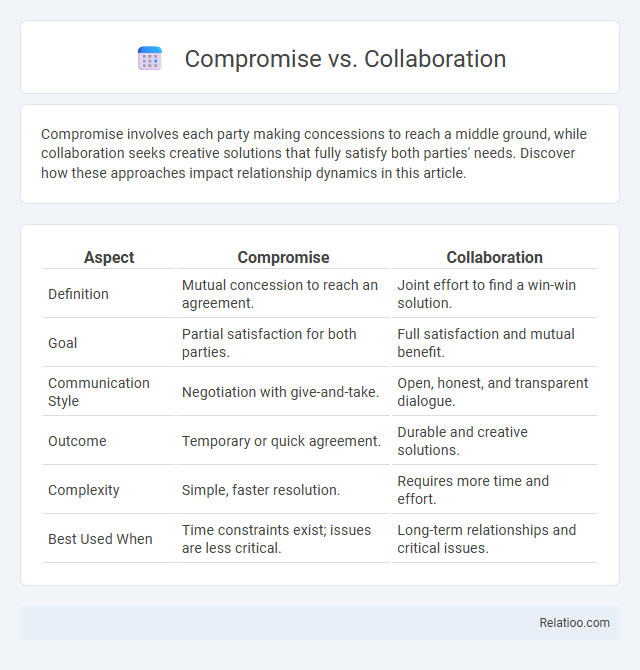Compromise involves each party making concessions to reach a middle ground, while collaboration seeks creative solutions that fully satisfy both parties' needs. Discover how these approaches impact relationship dynamics in this article.
Table of Comparison
| Aspect | Compromise | Collaboration |
|---|---|---|
| Definition | Mutual concession to reach an agreement. | Joint effort to find a win-win solution. |
| Goal | Partial satisfaction for both parties. | Full satisfaction and mutual benefit. |
| Communication Style | Negotiation with give-and-take. | Open, honest, and transparent dialogue. |
| Outcome | Temporary or quick agreement. | Durable and creative solutions. |
| Complexity | Simple, faster resolution. | Requires more time and effort. |
| Best Used When | Time constraints exist; issues are less critical. | Long-term relationships and critical issues. |
Understanding Compromise: Definition and Key Features
Understanding compromise involves recognizing it as a conflict resolution strategy where parties make mutual concessions to reach an agreement, balancing opposing interests. Key features include partial satisfaction for all involved, a focus on fairness, and quick, practical solutions without fully addressing underlying issues. Compared to collaboration, which seeks win-win outcomes through joint problem-solving, and competition that aims for one party's win, compromise offers a middle ground minimizing conflict intensity.
What is Collaboration? Exploring Key Concepts
Collaboration is a cooperative process where individuals or groups work together, sharing skills, knowledge, and resources to achieve common goals. Unlike compromise, which often involves concessions, collaboration seeks solutions that satisfy all parties by integrating diverse perspectives and fostering creativity. Effective collaboration emphasizes communication, mutual respect, and joint problem-solving to enhance productivity and innovation.
The Fundamental Differences: Compromise vs. Collaboration
Compromise involves each party conceding something to reach a mutual agreement, often resulting in a solution where neither side gets everything they want. Collaboration focuses on working together creatively to find a win-win outcome that satisfies the interests of all involved, promoting collective problem-solving. Understanding these fundamental differences helps you choose the best approach for conflict resolution or teamwork, ensuring more effective and sustainable results.
Pros and Cons of Compromise in Conflict Resolution
Compromise in conflict resolution offers the advantage of quick agreement by finding a middle ground acceptable to all parties, often saving time and preserving relationships. However, it may result in suboptimal outcomes where no party fully achieves their goals, potentially leading to dissatisfaction and recurring conflicts. Unlike collaboration, which seeks a win-win solution, compromise sometimes forces concessions that can undermine long-term commitment and overall solution quality.
Advantages and Disadvantages of Collaboration
Collaboration fosters diverse perspectives and enhances creativity by integrating multiple skill sets, leading to innovative solutions often unattainable through compromise or concession. The key advantage lies in achieving win-win outcomes that satisfy all parties, improving relationships and long-term cooperation. However, collaboration can be time-consuming, requiring significant communication and coordination, which may slow decision-making and create challenges if stakeholders lack trust or clear objectives.
When to Choose Compromise Over Collaboration
Choosing compromise over collaboration is effective when time constraints demand rapid decisions or when parties have conflicting priorities that make finding a win-win solution impractical. Compromise allows you to achieve a middle ground, ensuring progress without the detailed negotiation required in collaboration. Your approach should weigh the urgency and stakes of the issue to determine whether a quick resolution or a comprehensive agreement serves best.
Effective Strategies for Achieving Collaboration
Effective strategies for achieving collaboration focus on open communication, mutual respect, and shared goals, setting it apart from compromise by fostering a deeper level of cooperation. Unlike compromise, where parties may give up certain interests, collaboration seeks integrative solutions that satisfy all stakeholders, maximizing value. By embracing active listening and leveraging diverse perspectives, you can create an environment where innovative ideas thrive and collective success is prioritized.
Real-World Examples: Compromise vs. Collaboration in Action
Collaboration fosters innovative solutions by combining diverse perspectives, as seen in NASA's international space missions where experts unite to achieve complex goals. Compromise involves mutual concessions, exemplified by political negotiations where parties agree on middle ground policies to move forward. You can leverage collaboration for long-term success, while compromise suits situations requiring quick resolutions with acceptable trade-offs.
Common Misconceptions About Compromise and Collaboration
Common misconceptions about compromise and collaboration often confuse the two as identical conflict resolution methods, but they differ significantly in approach and outcomes. Compromise involves both parties making concessions to reach a middle ground, potentially leaving Your goals partially unmet, whereas collaboration seeks a win-win solution by integrating everyone's interests for optimal results. Understanding these differences enhances Your ability to choose the most effective strategy based on the situation's complexity and desired outcomes.
Building a Culture of Collaboration in Teams and Organizations
Building a culture of collaboration in teams and organizations involves prioritizing open communication, mutual respect, and shared goals over mere compromises that often result in partial satisfaction. Collaboration fosters innovation and trust by encouraging diverse perspectives to co-create solutions that benefit all parties involved, rather than settling for quick fixes or concessions. Emphasizing collaboration equips teams to address complex challenges effectively, driving sustained organizational growth and a resilient, inclusive workplace environment.

Infographic: Compromise vs Collaboration
 relatioo.com
relatioo.com